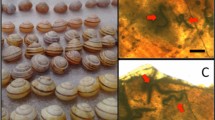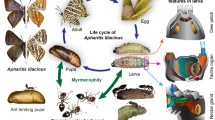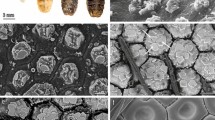Abstract
FOR examination of the biological basis of cyclic behaviour in doryline ants, the need to have extremely thin sections of brood material in complete series covering highly limited areas of tissues, from early developmental stages to adult, has led to the improved techniques reported here. The methods of fixing, sectioning and staining have made possible the fast routine processing of otherwise difficult, refractory materials through specimens representing a wide range of body-lengths. The linear dimensions of individuals comprising the polymorphic brood in the tropical American army ant, Eciton burchelli, for example, range from that of 0.5 mm in the microlarvae to 15 mm in the semi-pupae and callows of worker majors. Throughout such a range of material we are able to obtain a complete series of uniformly thin sections for each speciment, cut at thicknesses between 4 and 7 µ at any desired angle. These thin sections, moreover, are easily mounted in series for rapid examination because these techniques furnish ribbons of tissue without the loss of sections through knife-shattering or unevenness of material usual with other techniques we have tried (for example, refs. 1 and 2). Despite the thinness of the sections, it is a rare experience to lose even one of a series through its being shattered during sectioning or in handling.
This is a preview of subscription content, access via your institution
Access options
Subscribe to this journal
Receive 51 print issues and online access
$199.00 per year
only $3.90 per issue
Buy this article
- Purchase on Springer Link
- Instant access to full article PDF
Prices may be subject to local taxes which are calculated during checkout
Similar content being viewed by others
References
The Microtomist's Vade Mecum (Bolles Lee), edit. by Gatenby, J. B., and Painter, T. I., 163 (Churchill, London, 1937).
Storck, R. H., and Chadwick, L. E., Stain Tech., 39, 59 (1964).
‘ParaplastR’, product of Biological Research, Inc., St. Louis, Mo.
Gomori, George G., Amer. J. Clin. Path., 20, 665 (1950).
Gabe, M., Bull. Micro. Appliquée, Ser. 2, 3, 154 (1953).
Halmi, Nicholas S., Stain Tech, 27, 61 (1952).
Gillner, U., now Mrs. Ulla Geduldig.
Gillner, Ulla, and Olsson, Ragnar, Pub. Zool, Inst. Stockholm, (September 1960).
Schneirla, T. C., J. Comp. Psychol., 25, 51 (1938).
Schneirla, T. C., Proc. Amer. Philos, Soc., 101, 106 (1957).
Lappano, Eleanor R., Insect Soc., 5, 31 (1958).
Author information
Authors and Affiliations
Rights and permissions
About this article
Cite this article
LAPPANO-COLLETTA, E., GEDULDIG, U. & SCHNEIRLA, T. An Improved Histological Technique for Refractory Insect Brood Material in Research on Doryline Ant Behaviour. Nature 206, 959–960 (1965). https://doi.org/10.1038/206959a0
Issue Date:
DOI: https://doi.org/10.1038/206959a0
Comments
By submitting a comment you agree to abide by our Terms and Community Guidelines. If you find something abusive or that does not comply with our terms or guidelines please flag it as inappropriate.



